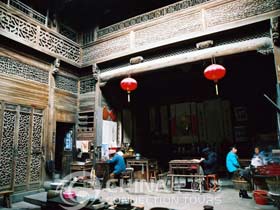
 The topography of Xidi Village is well planned. It boasts 122 dwelling houses in black, white and gray colors, and 3 clan temples were built in the 18th and 19th centuries (Ming and Qing Dynasties). Each has white walls, with elaborated-shaped eaves and courtyards. Most houses enjoy fine woodcarving and brick carving, etc, which reflect local culture and customs. It is called "the Land of Peach Blossom" for its beauty and tranquility. It is also called "a treasure house of ancient resident architecture" for its well-preserved ancient dwelling houses in Ming and Qing dynasties. The entrance gates and windows display typical features of local wood, brick and stone carving. Of particular interest is a glided balcony overreaching into the lane at Dafudi, the name of a clan hall, It was said that anyone fortunate enough to catch the colorful ball thrown by the young lady from the balcony could win her love. Crystal-clear water in the ditches connecting every household provide endless stream to the housewife for daily use. Standing tall at the village entrance is the Hu Wenguang Stone Archway, a single-structured and four storied building that is composed of three parts and supported by four pillars, the archway was a masterpiece of the Ming Dynasty architecture, testifying to the past prosperity of the village's history. Xidi was the residence of the Hu family, which claimed a Tang dynasty royal prince as its ancestor. Hu remains one of the most popular family names in southern Anhui, and in the modern era famous Hus from that region include Hu Shi, leader of the New Culture Movement and Nationalist China’s ambassador to the United States, and Hu Jingtao, current leader of the Chinese Communist Party. As a cultural site, Xidi Village was added to the list of World Heritage by UNESCO in 2000.
The topography of Xidi Village is well planned. It boasts 122 dwelling houses in black, white and gray colors, and 3 clan temples were built in the 18th and 19th centuries (Ming and Qing Dynasties). Each has white walls, with elaborated-shaped eaves and courtyards. Most houses enjoy fine woodcarving and brick carving, etc, which reflect local culture and customs. It is called "the Land of Peach Blossom" for its beauty and tranquility. It is also called "a treasure house of ancient resident architecture" for its well-preserved ancient dwelling houses in Ming and Qing dynasties. The entrance gates and windows display typical features of local wood, brick and stone carving. Of particular interest is a glided balcony overreaching into the lane at Dafudi, the name of a clan hall, It was said that anyone fortunate enough to catch the colorful ball thrown by the young lady from the balcony could win her love. Crystal-clear water in the ditches connecting every household provide endless stream to the housewife for daily use. Standing tall at the village entrance is the Hu Wenguang Stone Archway, a single-structured and four storied building that is composed of three parts and supported by four pillars, the archway was a masterpiece of the Ming Dynasty architecture, testifying to the past prosperity of the village's history. Xidi was the residence of the Hu family, which claimed a Tang dynasty royal prince as its ancestor. Hu remains one of the most popular family names in southern Anhui, and in the modern era famous Hus from that region include Hu Shi, leader of the New Culture Movement and Nationalist China’s ambassador to the United States, and Hu Jingtao, current leader of the Chinese Communist Party. As a cultural site, Xidi Village was added to the list of World Heritage by UNESCO in 2000.

